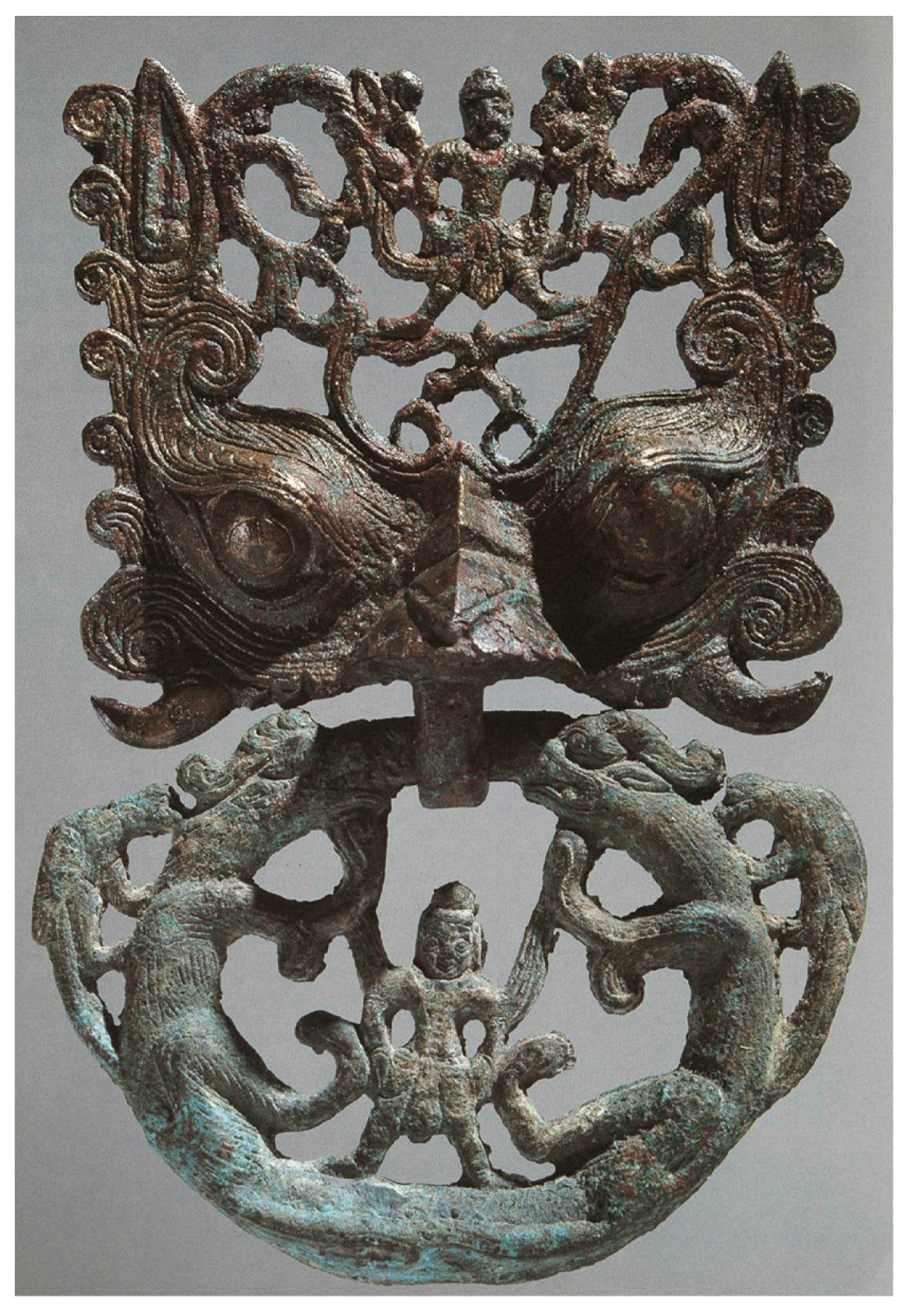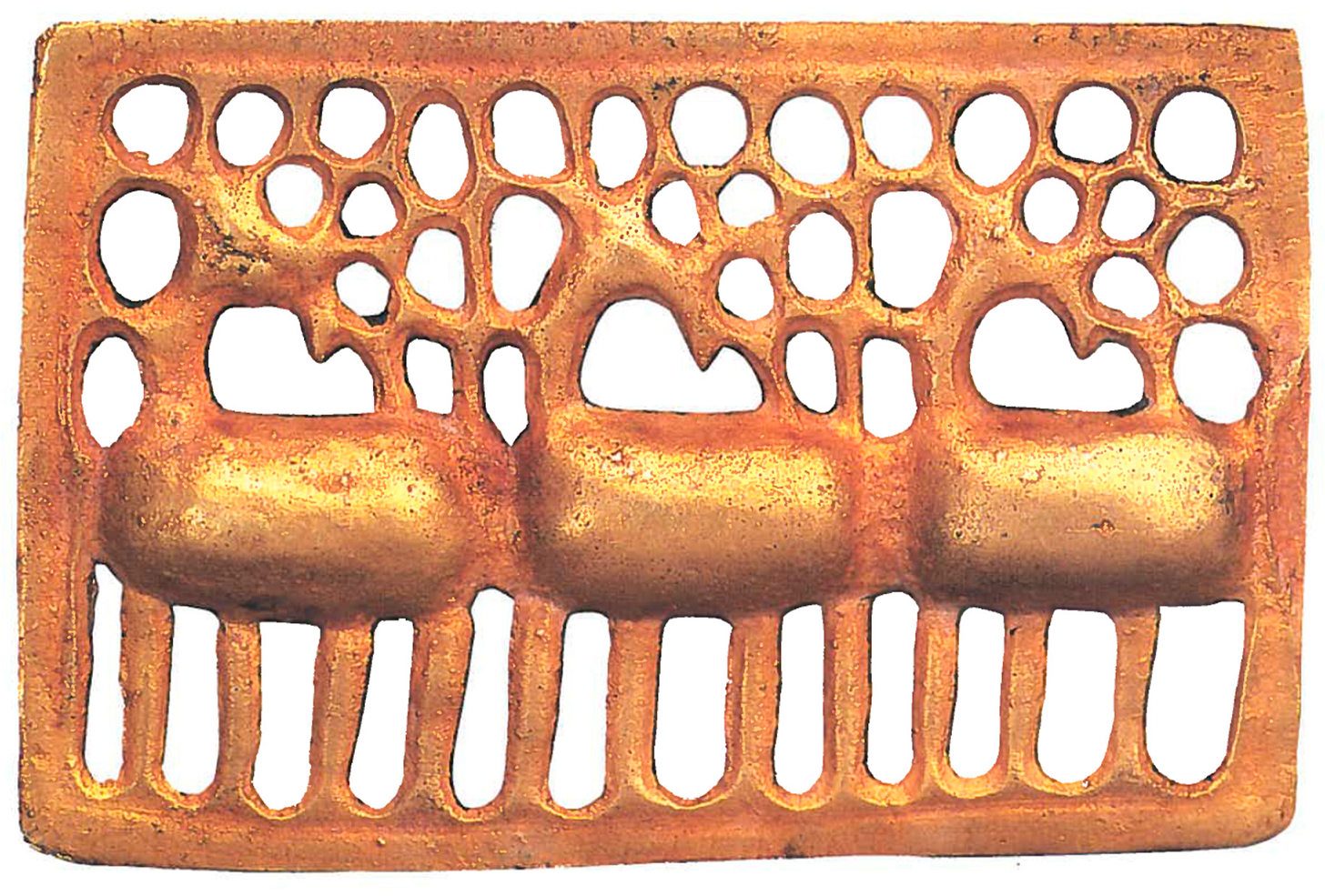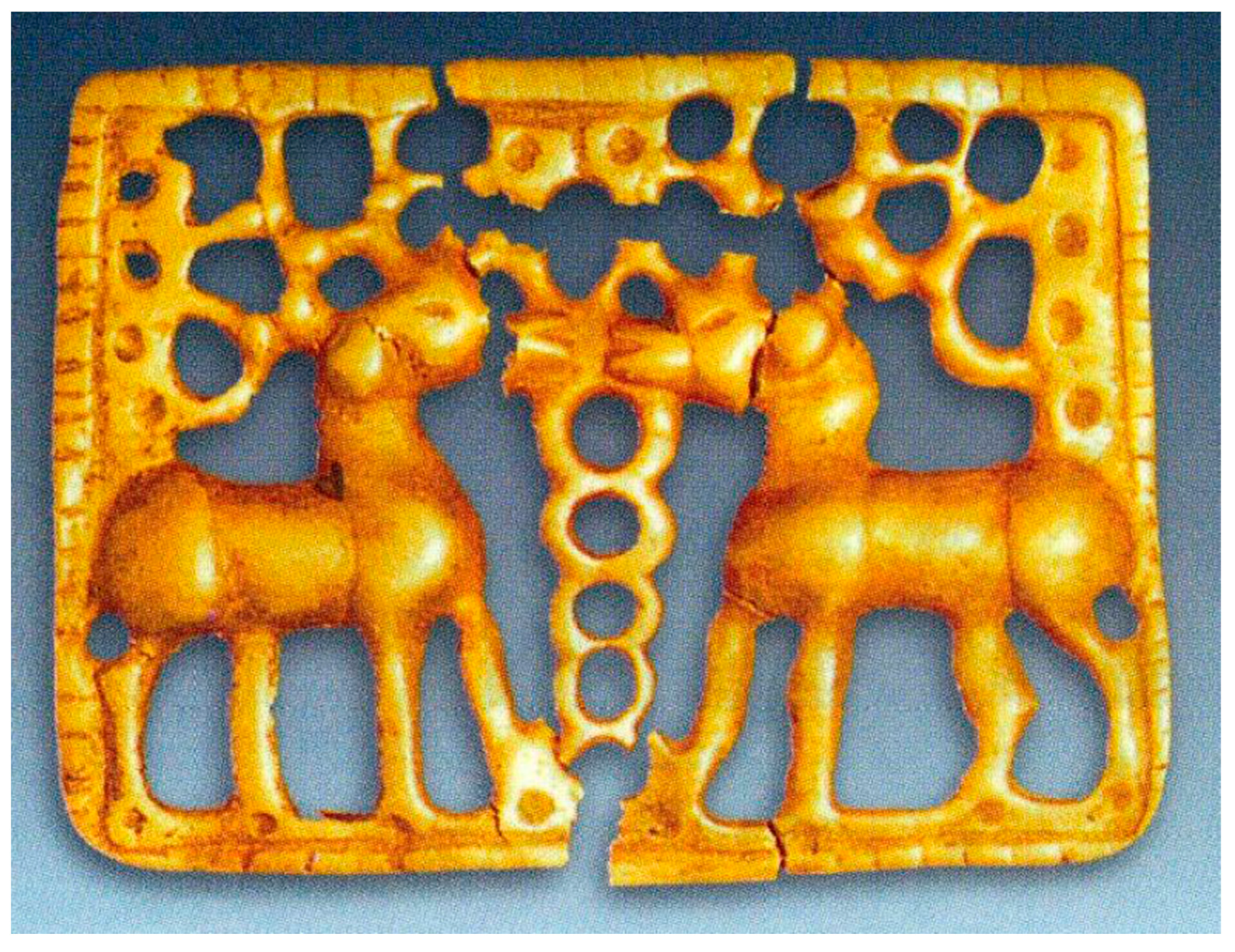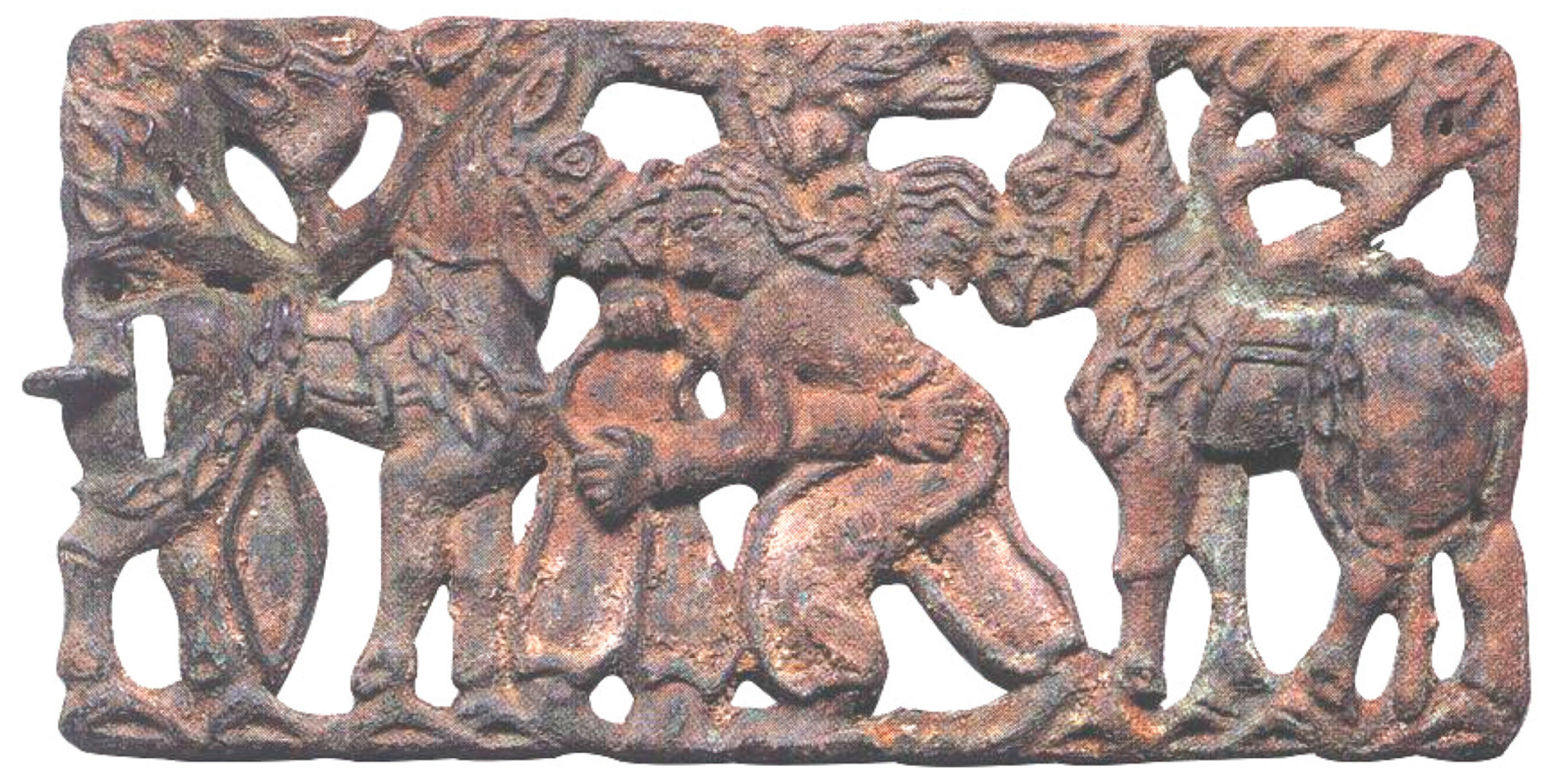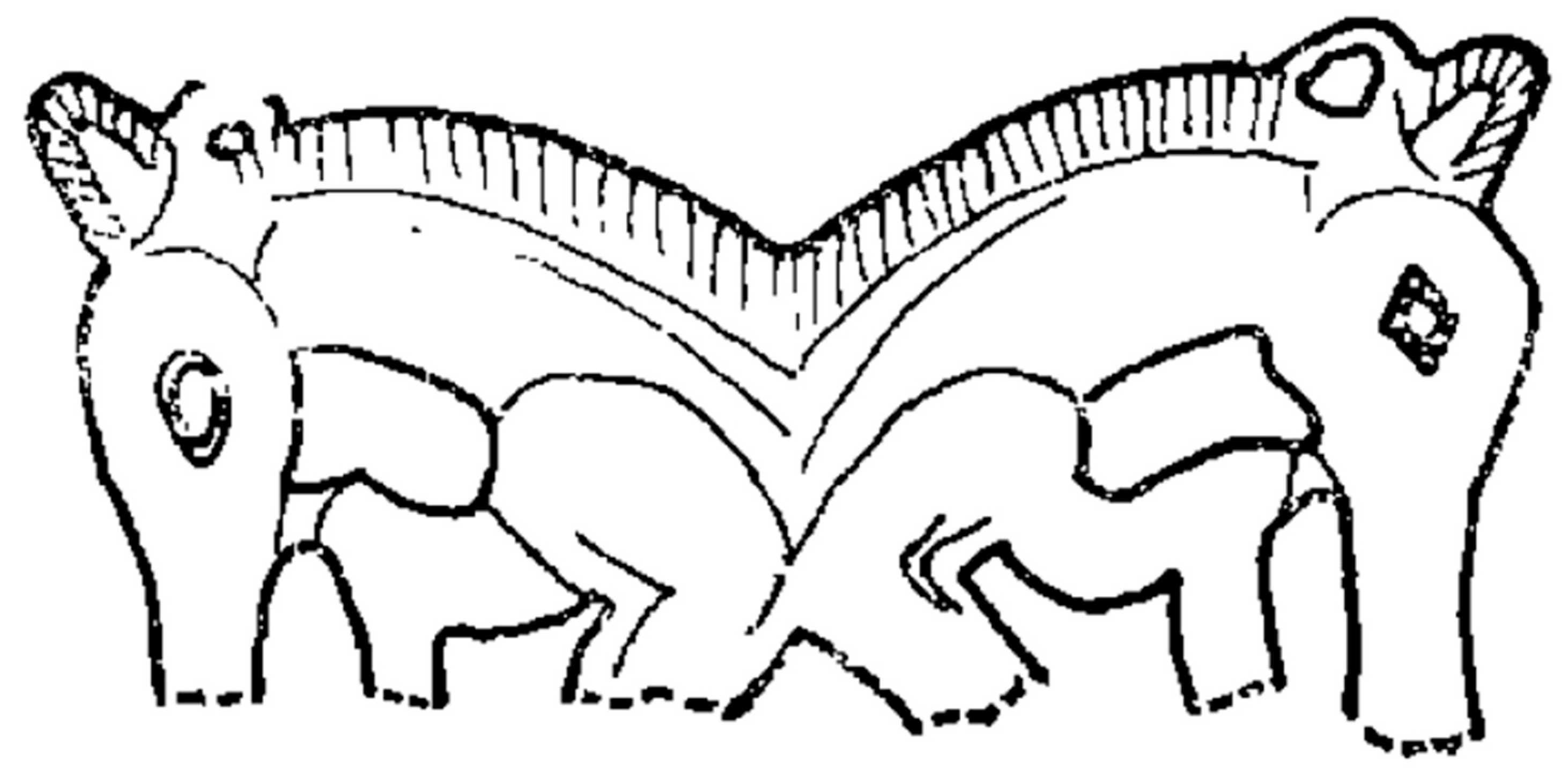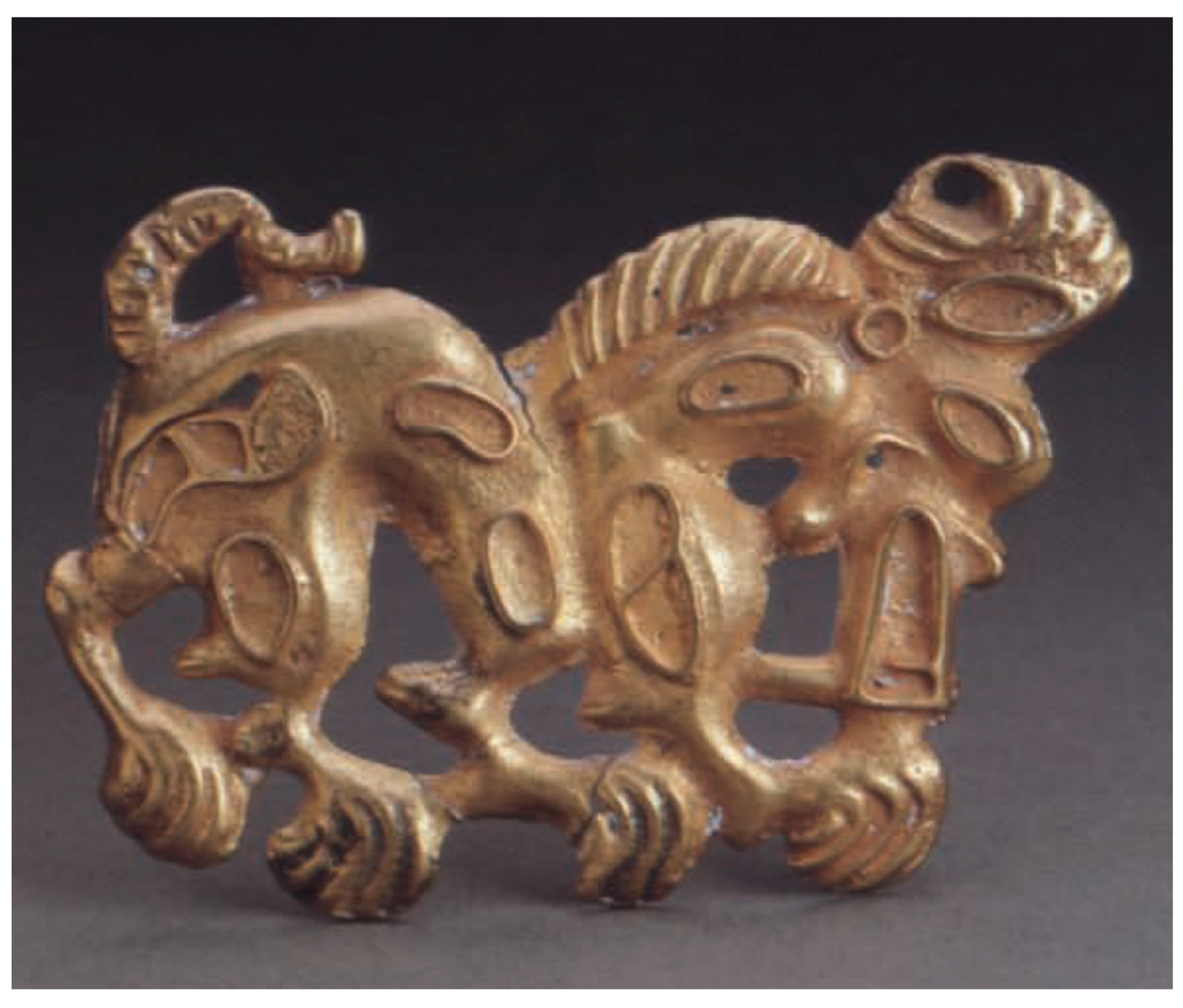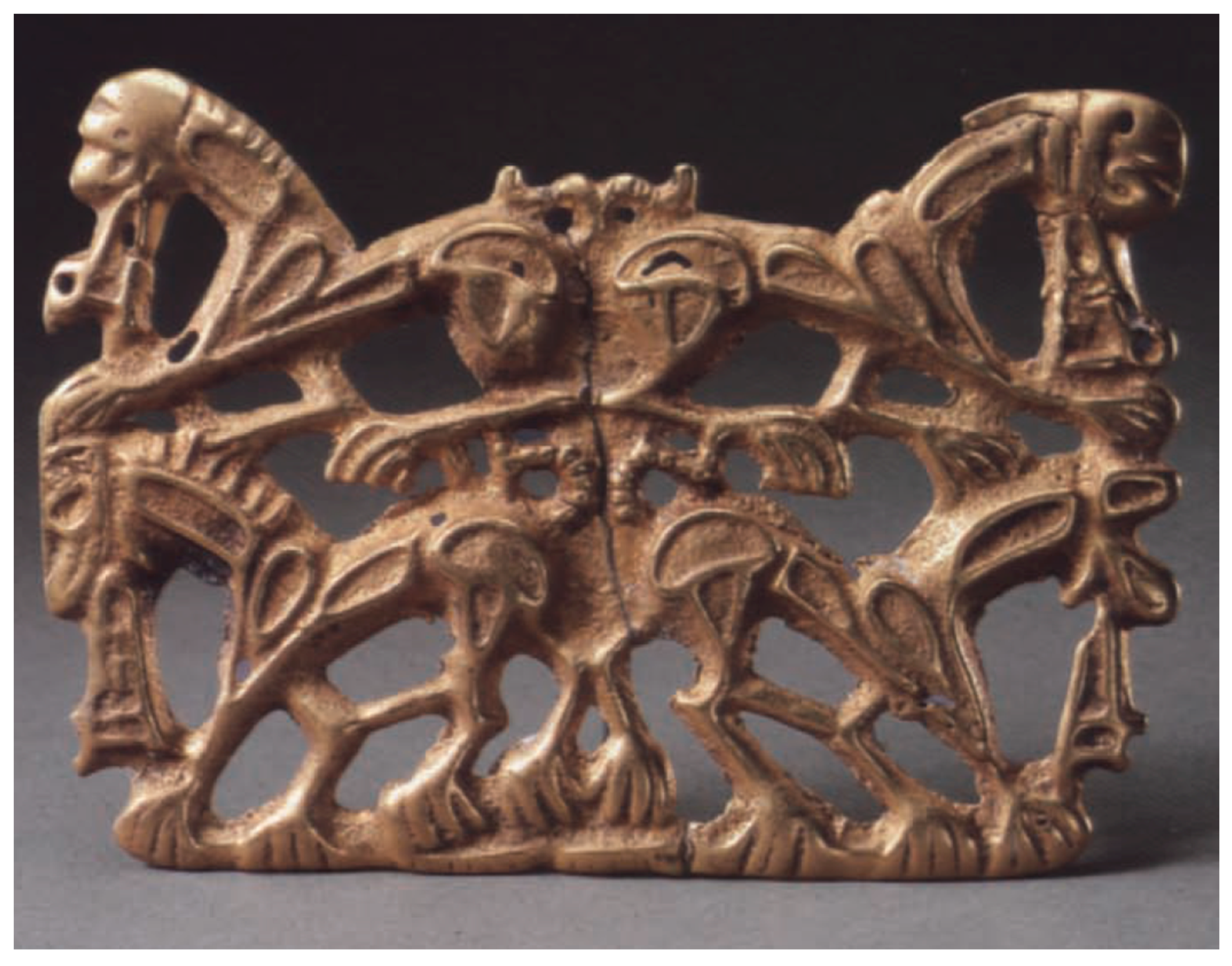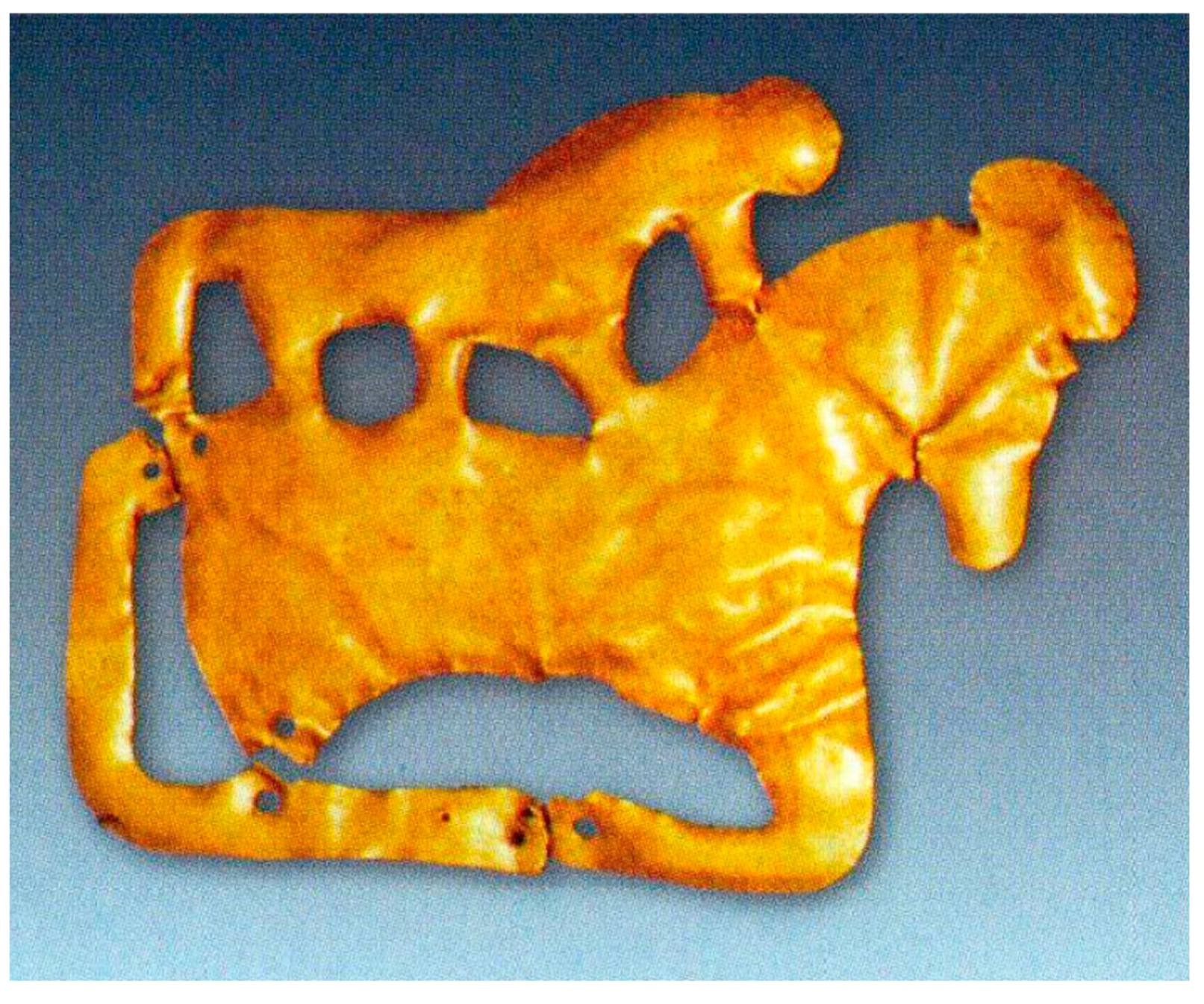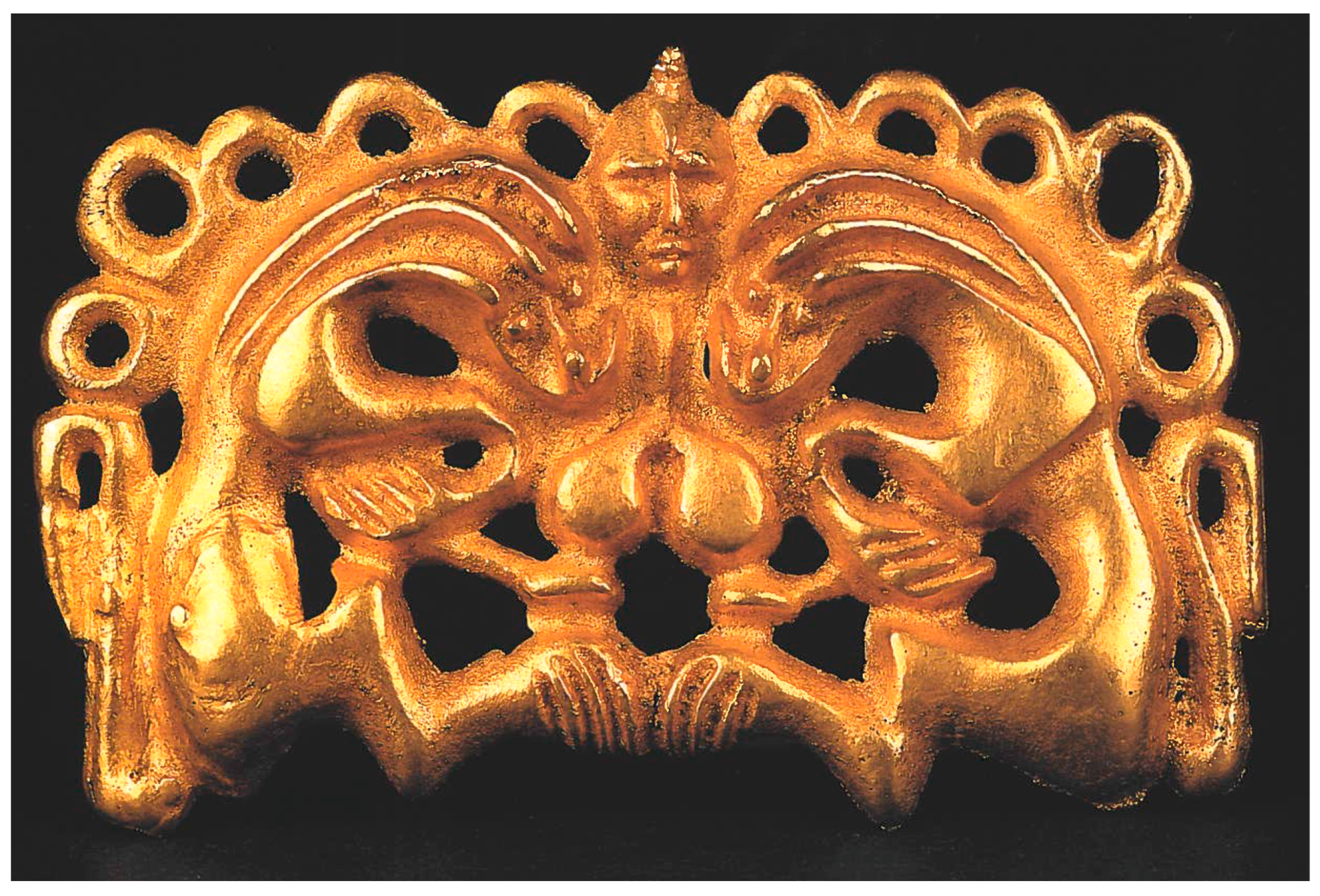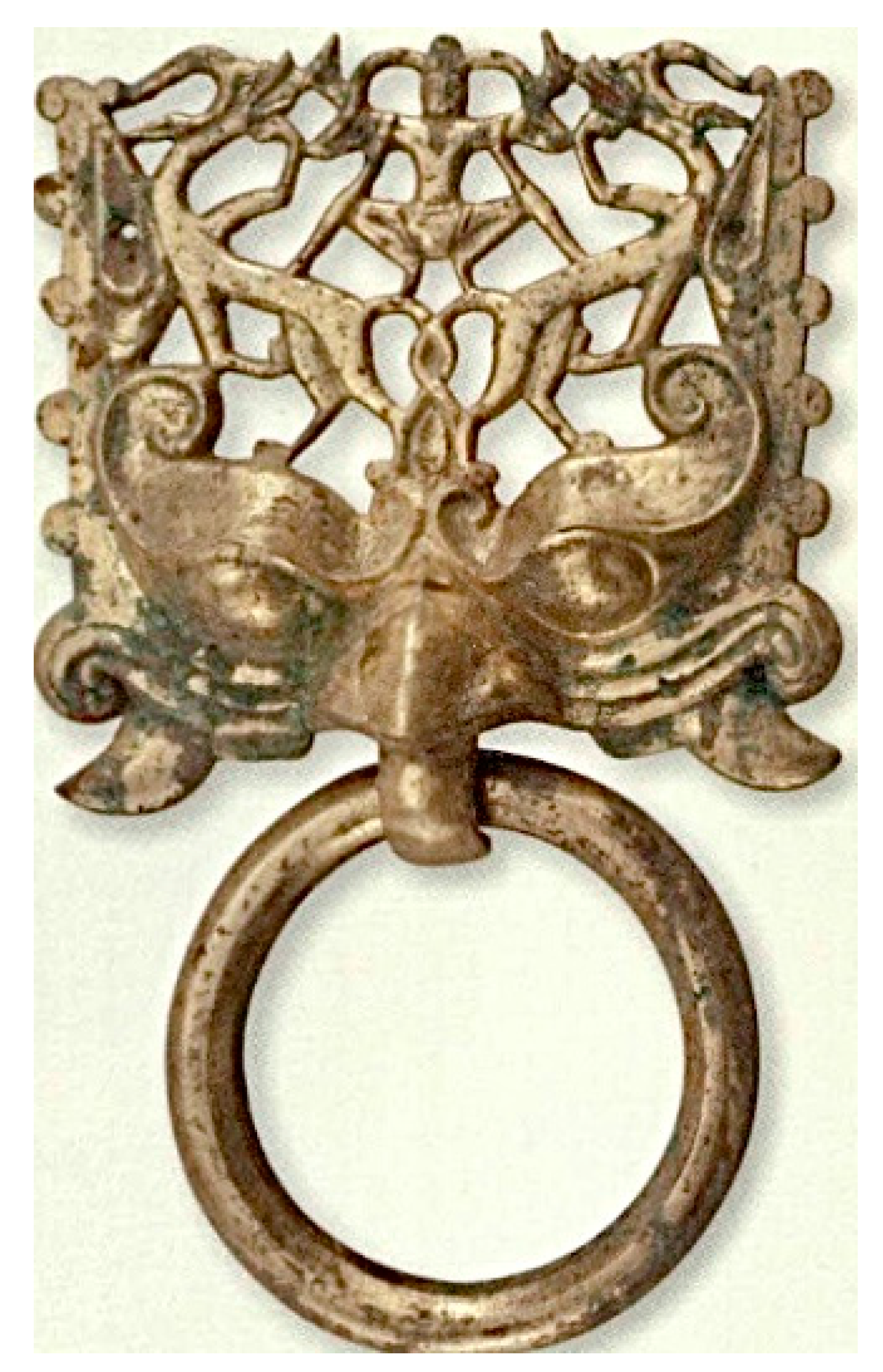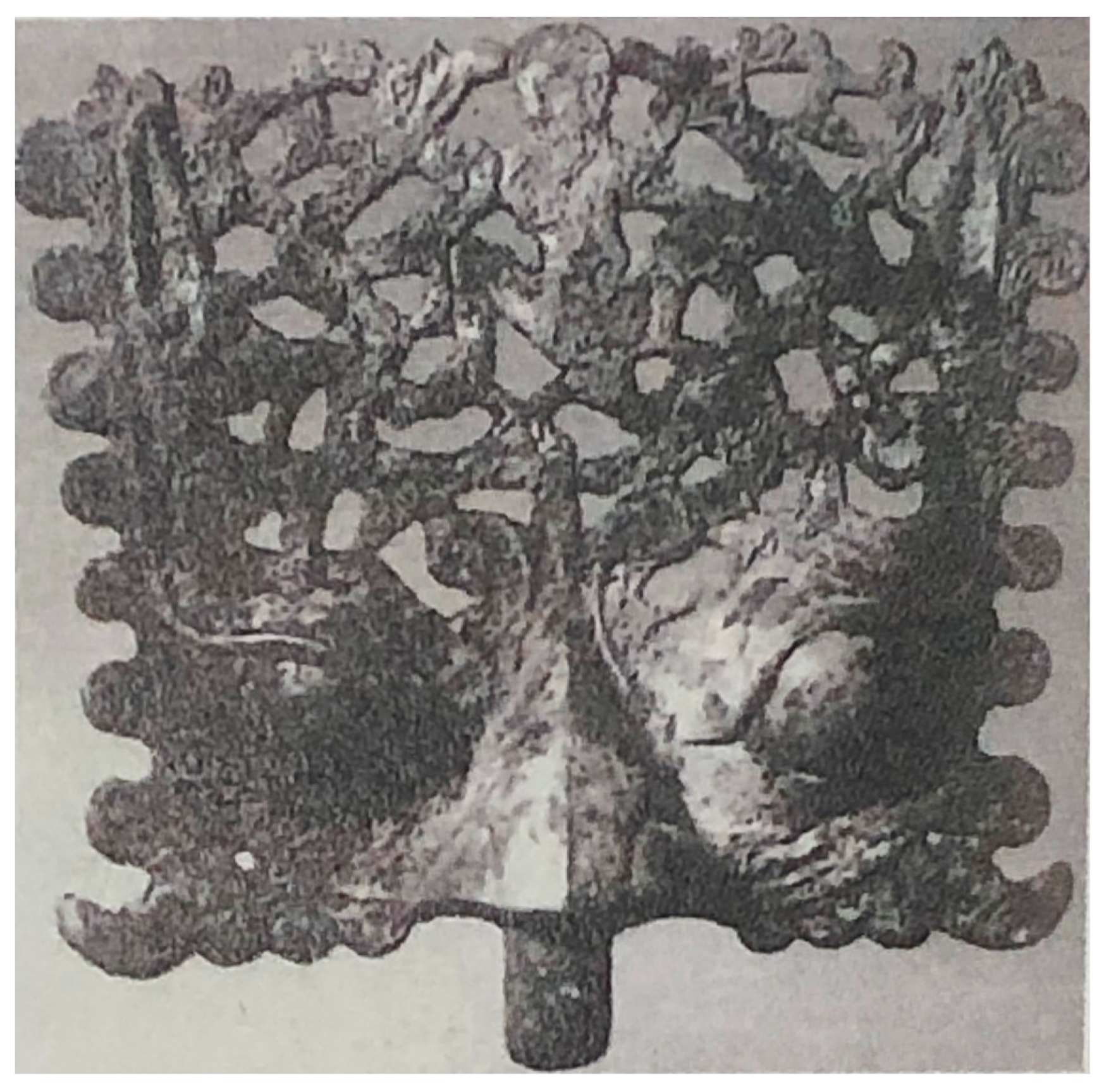1. Introduction
The Xianbei 鮮卑 people were a non-Chinese group that was active in Northeast Asia from the turn of the common era to the early medieval period
1. Being the major player on the Mongolian-Manchurian steppe after the fall of the Xiongnu 匈奴 Empire, the Xianbei people significantly shaped the political, cultural, and artistic landscape of ancient eastern Eurasia (
Ma 1962;
Holcombe 2013). The Xianbei people led a hunting-gathering and pastoral way of life before they became more sedentary in North China during the fourth century (
Kang 1995, pp. 6–10). They heavily depended on animals to obtain subsistence for their livelihood, to organize their social structure, and to construct the symbolism of their belief systems. The consistent interaction between humans and non-human animals inspired a variety of zoomorphic designs in Xianbei visual culture that include both real beasts and mythical creatures. This paper investigates Xianbei animal art, particularly zoomorphic motifs on gold and bronze plaques, to better understand the human–animal–environment engagement in the eastern Eurasian steppe from the first to the fifth century CE.
The visual representation of animals offers a non-anthropocentric lens to study the relationship between humans and animals. For a long time, animals have been regarded as passive beings, subjective to the dominance of humans. However, within the framework of Human-Animal Studies, which emphasizes a balanced dynamism between the two, animals are autonomous entities with an active agency, more than passive economic resources to be exploited (
Marvin and McHugh 2014). Along with the “animal turn” in recent scholarship, scholars challenge anthropocentricity by not only acknowledging the agency of animals but also proposing interspecies engagement that bypasses the nature–culture divide (
Overton and Hamilakis 2014). While animal remains, such as bones, afford archaeologists evidence to explore the interface between humans and animals (
Armstrong Oma and Birke 2013), image-bearing objects, including zoomorphic metal plaques, provide art historians with a valuable set of materials to investigate the functional and symbolic significance of animals to human beings.
Over the past decades, an increasing number of metal plaques labeled as Xianbei were published in both archaeological reports and exhibition catalogues. These plaques include belt buckles, ornamental pendants, clothes attachments, etc. The complexity of Xianbei metalworks is related to the mixed nature of the Xianbei population and the cultural-political diversity within the Xianbei society. After a brief unified period under its leader Tanshihuai 檀石槐 in the second century CE, the Xianbei confederation broke into various groups, including Tuoba 拓跋, Murong 慕容, Tuyuhun 吐谷渾, etc., who created multi-ethnic polities along the frontiers across North China (
Holcombe 2013, pp. 8–9). This research focuses on excavated artifacts from Xianbei archaeological sites, especially those associated with the Tuoba clan. According to the preface to
Wei shu, the Tuoba clan of the Xianbei people originated from the mountainous region near the modern-day border between China, Mongolia, and Russia. They eventually settled in North China, where they established the Northern Wei dynasty (386–534 CE) after migrating via the southern Mongolian Plateau (
Wei 1974, p. 1;
Holmgren 1982). While the majority of excavated zoomorphic plaques were discovered from burials, they were not exclusively produced for the funerary purpose. Crafted from precious metals, including gold and gilt bronze, the zoomorphic plaques were likely used by their owners during their lifetime and later buried in tombs. By mapping out the distribution of the precious metal objects, it is possible to trace the movement of the Xianbei people. This study also pays attention to the use-context of the metal plaques, which sheds light on the interaction among the objects, the animals they portray, and the users of the plaques. Adorning the human body or man-made structures, the metal plaques with animal motifs act as the nexus of the human and natural worlds.
This article adopts an ecological perspective to examine visual representations of animals on metal plaques associated with the Xianbei people, especially the Tuoba clan. To unpack the various roles that animals played in the Xianbei society and the human-environment entanglement, I highlight three major motifs on the Xianbei zoomorphic metal plaques: the deer, the horse, and the human–animal juxtaposition. Each motif experienced a change in design over time and was distributed across the Mongolian-Manchurian steppe and North China. An investigation of the evolving designs of animal motifs and the geographical distribution of the zoomorphic plaques will contribute to our knowledge of the possible migration routes of the Xianbei people. As mentioned earlier, there are various groups within the Xianbei community who went through divergent trajectories of migration and interacted with their neighbors of Eastern Han and Xiongnu differently (
Fan 1965, p. 2986). Therefore, the path of movement proposed in this paper is one of the many possible routes taken by the Xianbei people. The aim of this paper is not to create a linear narrative of the migration history of Xianbei; rather, I aim to offer an ecological perspective of Xianbei material remains, which enables a discussion on a potential migration pattern. Moving across a vast land encompassing diverse ecological zones, the Xianbei people were engaged with local flora and fauna in different ways, which is reflected in the design and usage of metal plaques featuring animal motifs.
2. Deer Plaques: From Mountains to Steppes
The deer motif was one of the most iconic designs of Xianbei metalworks (
Table 1). Zoomorphic plaques featuring deer motifs are widely distributed across current-day Inner Mongolia from the first to the third century (
Scheme 1). Among a dozen deer plaques discovered from Xianbei archaeological sites, I distinguish two major groups: the first group depicts three deer standing in a row, and the second group is decorated with two deer facing each other. In what follows, I will first offer a detailed visual analysis of each group and then contextualize these two designs against changing environments where the Xianbei tribesmen lived.
The first group of deer plaques features three identical deer standing in a row amid a patterned background of abstract foliage (
Figure 1). Up to the present, there are at least eight examples of the three-deer plaques retrieved from both archaeological excavations and through chance finds across the Mongolia-Manchurian grassland. The animal and foliage are framed within a rectangular square measuring 6.8 by 4.5 cm, a relatively standardized size for belt plaques. Each of the deer turns its head back toward the capsule-shaped body supported by four cylindrical legs. The foliage background is highly abstract, representing leaves through circular openwork. As pointed out by previous scholarship, the design of both the deer and the leaves are geometricized and stylized, characteristic of Xianbei metalwork (
Watt et al. 2004, p. 126). It is also worth noting that the animal body and the natural vegetation are organically intertwined—the slightly curved necks and backward-turning heads of the deer are connected to the leaves; the legs of the animal, occupying the lower half of the composition, can also be interpreted as tree trunks from which the foliage grows.
The earliest examples of three-deer plaques were found in Xianbei burials at the Jalainur 扎賚諾爾 cemetery in Inner Mongolia, and were dated to the first and second centuries CE (
Zheng 1961;
Wang 1987;
Neimenggu Wenwu Kaogu Yanjiusuo 1994). Located near the present-day border of China, Russia, and Mongolia, the Jalainur cemetery is one of the many Xianbei burial remains scattered around Lake Hulun 呼倫湖.
2 Lake Hulun, a freshwater lake covering approximately 900 square miles (2331 km
2) and only 13 miles (21 km) south of the cemetery, is regarded by many scholars as the
da ze 大澤, or the “Grand Marsh”, to which the Xianbei tribes migrated around the turn of the common era.
3 The giant lake opens to the Greater Khingan Range in the east and pastoral grasslands in the west. The meandering hills of the Great Khingan Range are identified by scholars as the Great Xianbei Mountain 大鮮卑山, the homeland of the Tuoba Xianbei recorded in
Wei shu, the official dynastic history of the Northern Wei.
4Having access to mountains and grasslands, the Xianbei people who settled around Lake Hulun practiced both hunting-gathering and pastoral nomadism. Textual records concerning the early history of the Tuoba Xianbei state that their ancestors conducted animal husbandry, migrated, and engaged in hunting 畜牧遷徙, 射獵為業 (
Wei 1974, p.1). Archaeological evidence further attests to hunting activities among the Xianbei tribesmen in this region. A plaque made of animal bones was excavated from the Jalainur cemetery in 1960 (
Gai 1964). Within a narrow space of 15 cm long and 2.5 cm wide, it depicts a hunter shooting a deer with a bow and arrows (
Figure 2). The Greater Khingan Range has long been the main habitat for various species of deer, including elk, reindeer, sika deer, and so forth. Prehistoric rock paintings hidden in the wild forests along Jiaolaokedao River 交唠呵道河 in the Hulunbuir region depict four different species of deer (
Zhao 1987), showing humans’ insightful understanding of the animals. The three-deer motif on Xianbei metal plaques, featuring the organic integration of deer and lush vegetal background, likely reflects the natural environment of the Greater Khingan Range.
However, deer were not merely humans’ hunting targets. As Esther Jacobson articulated in her study of Scytho-Siberian deer images, deer played a symbolic role as the Mother Goddess affording a source of life and death in ancient Siberian cultures during the first millennium BCE (
Jacobson 1993). Rane Willerslev’s study of Yukaghris, indigenous hunters in northeastern Siberia, demonstrates that animals could be perceived as animated beings in the hunter community (
Willerslev 2004, pp. 633–34). Ethnographical studies of the Evenks, who dwelled in northeastern Siberia and the Greater Khingan Range of northeast China today, suggest a co-dependent relationship between humans and reindeer. The animal not only acted an instrumental role in Evenks’ seasonal migration but also assumed the magic power of facilitating a soul-journey (
Vitebsky 2005). It is not farfetched to propose that deer might have assumed a similar part in the Xianbei society. According to
Wei shu, the Xianbei people intended to move further south after residing around the Grand Marsh for generations (
Wei 1974, p. 1). However, their journey was hindered by dangerous mountains and valleys. It was under the guidance of a magic animal that the Xianbei people were able to navigate the labyrinthic landscape and eventually settled in the former Xiongnu territory. The magical animal was recorded to have the form of a horse and the voice of a bull 有神獸, 其形似馬, 其聲類牛. Scholars have proposed different interpretations regarding which animal the spirit beast was. Some claim it could be a kind of cervid (
Sun 2007, p. 73;
Chen 2012, pp. 50–54). The deer continued to maintain a symbolic significance even after the Tuoba Xianbei settled in North China. They were regarded as an auspicious omen and their miraculous appearances were documented in the
Treaties on Spirited Manifestation 靈徵志 of
Wei shu (
Wei 1974, p. 2930). Even the reign title of Emperor Taiwu 太武 (408–452) was changed to
shenjia 神麚 (spirited stag) after white stags were spotted at Dingzhou 定州and Laoling 樂陵 on the Yellow River plains in 428 CE.
The three-deer plaques, first found at Jalainur cemetery, continued to be part of the Xianbei burial assemblage of a later date around the late second and third centuries as the people migrated southwards. Xianbei sites located in modern-day Qahar Right Rear Banner 察哈爾右翼後旗, occupying southern Inner Mongolia, uncovered at least three examples with the three-deer motif, respectively, from Sandaowan 三道灣, Erlanhugou 二蘭虎溝, and Jingtancun 井灘村 (
Wei 2004, pp. 16–54;
Zheng and Li 1964;
Zhang 1995, p. 79). The three-deer plaques from Qahar Right Rear Banner exhibit similar composition and stylistic features to those discovered in Jalainur, showing the continuity of Xianbei visual culture.
In addition to the three-deer plaque, archaeological sites in the Qahar Right Rear Banner of the southern Mongolian steppe revealed a new design of deer plaques that arrange two deer symmetrically within the rectangular frame. Two examples were discovered and published, one from Sandaowan, and the other from Erlanhugou (
Wei 2004, pp. 16–54;
Zheng and Li 1964)
5. Unlike the three-deer plaque depicting deer striding in the same direction, the more recently-developed plaque design features two deer standing facing each other toward the center (
Figure 3). The pair of deer are on two sides of a tree whose trunk serves as the central axis of the symmetrical design. Tree branches and leaves also grow symmetrically over the two facing deer. While the new design inherited the geometricized treatment of the animal and the plants, it gives more attention to the anatomy of the deer, creating a more naturalistic representation of the animal. The body of the deer is no longer a capsule-like tube but differentiates the forequarter and hindquarter. The legs are not represented as cylindrical trunks, as those in the three-deer plaque are. Instead, artisans made efforts to reveal joints. The varied positions of the four legs also create a sense of motion, in contrast to the static pose of the three deer standing rigidly upright.
The development of the symmetrical composition in the twin-deer plaque is likely inspired by the artistic tradition of the Xiongnu Empire, a formidable nomadic regime dominating the Mongolian Steppe from the third century BCE to the first century CE. Located north of the Yinshan 陰山 Mountain, the burial sites of Sandaowan and Erlanhugou open toward a vast stretch of pastoral land. This region used to be “the old lands of the Xiongnu” 匈奴之故地 (
Wei 1974, p. 2). After the power of the Xiongnu declined toward the end of the first century, Xianbei groups seized a large portion of the former Xiongnu territory. Meanwhile, hundreds of thousands of Xiongnu horsemen who remained in the area all proclaimed themselves as Xianbei (
Fan 1965, p. 2986).
6 Inheriting the land of Xiongnu and integrating people who used to live under the regime of Xiongnu enabled the immigrant Xianbei people to absorb their predecessor’s visual culture.
7 The symmetrical design is prominent in Xiongnu animal art, as shown in mirror-image motifs on its metal belt buckles (
Bunker 1997, p. 256). The bilateral symmetry along the vertical axis, as Andreeva pointed out, owed largely to the Chinese visual vocabulary and was found across the Ordos region as well as North China (
Andreeva 2022, pp. 20–27). Take the decorative gold foil from Xigoupan 西溝畔 cemetery in south Inner Mongolia for example; it portrays two confronting horses facing each other (
Yikezhaomeng Wenwu Gongzuodui and Neimenggu Wenwu Gongzuodui 1980). A bronze plaque depicting two wrestlers and their horses under trees in a symmetrical manner along the central axis offers a visual parallel to the Xianbei twin-deer design against the vegetal background (
Zhongguo Kexueyuan Kaogu Yanjiusuo 1962, pp. 138–39) (
Figure 4). It is possible that when the Xianbei people took control of the land of Xiongnu, the remaining Xiongnu zoomorphic design sparked the creation of the new symmetrical arrangement of deer underneath the tree.
The evolving patterns of the metal plaques from the three-deer motif to the twin-deer design correspond to the migration of the Xianbei people from the Greater Khingan Mountain to the Mongolian Steppes. As their living environment changed, the Xianbei people engaged with nature and animals differently. Around Lake Hulun, the Xianbei people were actively involved in hunting and animal husbandry. The deer depicted against the foresty background captures the key elements of the ecological system along the Greater Khingan Range. When the Xianbei tribesmen moved to the former territory of the Xiongnu in the southern part of the Mongolian Steppe, their design of deer plaques gained a new taste inspired by the Xiongnu visual culture. The following section, focusing on the horse motif, will further shed light on the evolving human–animal relationship as the Xianbei people migrated from the mountains to the steppes.
3. Horse Plaque: From Divine to Domestic
The second group of animal plaques associated with the Xianbei people is dedicated to the depiction of the horse, a socially-significant animal for the nomadic community (
Müller 2009). The images of horses not only appear on metal plaques, but also on ceramic vessels (
Zhang 1989, p. 431). The skulls of horses placed next to the heads of the deceased in Xianbei tombs prove that the animal was used as a sacrifice in burial rituals (
Wei 2004, pp. 212–35). In comparison to deer motifs, horses depicted on the Xianbei metal plaques show a greater variety of designs, which I categorize into two major groups— the galloping horse and the crouching horse. I argue that these two distinctive visual representations of horses embody different relationships between humans and animals as the Xianbei people migrated to the steppes and adopted a new way of living.
Up to the present, the majority of galloping horse plaques have been discovered in the Lake Hulun region (
Zheng 1961). These plaques feature a horseshoe shape; perforations on the two ends indicate that they were likely attached to other organic materials to be used as belt buckles (
Figure 5). The motif of galloping horses is cast in relief by bronze with traces of a gilding layer. The horse extends the forelegs, moving toward the rounded side of the plaque; the hind legs are bent to fit the narrower end. Its flank is muscular. Thick manes grow along the neck. Among the three pieces retrieved from the Jalainur cemetery, two depict galloping horses with wings. The pair of wings growing from the shoulder are represented with great detail, showing arrays of feathers. The galloping horse is portrayed as a divine being rather than a terrestrial animal, conveying its power independent of human intervention.
The rationale behind the design of the heavenly appearance of horses can be found in a
Wei shu entry regarding a mythical beast. As mentioned earlier, scholars have proposed different interpretations of the mythical animal that played an instrumental role in the migration history of Tuoba Xianbei. Some claim it could be deer; some scholars refute this hypothesis by citing textual sources linking spirited beast to ox (
Yang 2007, p. 212); and some believe that the sacred animal could be a horse. I suggest that the exact identification might not be essential, since the spirited beast might not even be found on earth. It is the supernatural power of the animal that matters. What is emphasized in the text is the critical role played by the mythological animal and its capability of leading the Xianbei people to travel through the precipitous mountains and deep valleys.
8 The perception of an animal as an active agent with supernatural power explains the celestial representation of galloping horses with wings, a visual image imbued with miraculousness.
In comparison to the powerful depiction of the galloping horse, the crouching horse appears to be ordinary, earthly, and tamable. Metalworks decorated with crouching horse motifs are not cast in relief on the horseshoe-shaped plaque. Instead, they show the contour of the animal in openwork. The horse plaque from a late second and early third century site in Liujiazi 六家子, Horqin Left Middle Banner 科爾沁左翼中旗, Inner Mongolia, depicts a horse crouching on the ground with its legs bent (
Zhang 1989) (
Figure 6). The head of the horse is facing down; his mouth is elongated, touching the ground. The mane along the neck is given excessive attention with hair being meticulously articulated. The horse plaque is attached to a chain made with interlocking rings, indicating it was hung on human bodies rather than attached to other materials. The second horse plaque from the same site arranges two horses symmetrically with their heads facing outward (
Zhang 1989) (
Figure 7). The depiction of the horses shares stylistic features with the single-horse pendant. Two holes were found right behind the ears, indicating that the plaque could be hung in a similar manner to the crouching horse pendant.
The crouching horse pendant might have served as a prototype for an abstract design known as the “beast-shaped” motif (
Figure 8). The beast-shaped plaques, also discovered in Liujiazi cemetery, are highly stylized, depicting an animal with a twisted torso (
Zhang 1989;
Watt et al. 2004, p. 127). Despite its abstract rendition, the beast-shaped plaque reveals a similar configuration to the horse plaque: a profile of the animal with bending legs, a prominent eye with pupil, and a carefully depicted mane. The beast, however, features powerful claws rather than hoofs. Enclosures formed by raised lines on the surface accentuate parts of the body. This design can multiply to generate a more complex composition. The gold animal plaque excavated from Liangcheng 涼城, Inner Mongolia was made of four units of the beast-shape motif, aligned symmetrically along a vertical axis and facing outwards (
Zhang 2002;
Watt et al. 2004, pp. 127–28) (
Figure 9). The back of the plaque is inscribed with three characters,
Yituo jin, 猗㐌金, or Gold of Yituo, indicating that it was associated with one of three leaders in charge of the tripartite Xianbei confederation in the late third and early fourth century.
The image of a crouching horse is also found on a group of plaques that feature a small creature on the back of a larger horse (
Figure 10). Five specimens of this type have been unearthed from the Sandaowan cemetery in Inner Mongolia and the Houbaoshi 后寶石 cemetery in Jilin Province. Previous studies identify the small-sized creature on the top as a baby horse (
Bunker 1997, p. 283). However, due to the abbreviated form, we could not rule out the possibility that the smaller figure could be a horse rider. In either scenario, the larger horse is portrayed in a static pose with forelegs and hind legs bending on the floor, thus in sharp contrast to the galloping horse in motion. The size of these plaques is relatively small compared to all examples above (see
Table 1). Tiny holes penetrating the surface suggest that the plaques were originally attached to textiles or other fabrics.
An investigation into the spatial distribution of the horse plaques demonstrates the two types of horse plaques were from two regions with distinctive ecological environments. While metal plaques featuring winged horses were found around Lake Hulun, the crouching horse motifs spread across the southern part of the Mongolian-Manchurian steppe. According to the typological study of Xianbei archaeological remains by Ni Run’an, the wide distribution of the crouching horse plaques constitutes part of the burial assemblage that corresponds to the cultural sphere of the Xianbei confederation founded by Tanshihuai in the second half of the second century CE (
Ni 2010, p. 109). Tanshihuai allegedly ruled a vast land measuring 4000
li east–west bound and 7000
li north–south bound. He defeated Dingling 丁零 in the north, suppressed Fuyu 扶餘 in the east, attacked Wusun 烏孫 in the west, and completely occupied the land of Xiongnu (
Fan 1965, p. 2989).
In his seminal paper “From Trust to Domination,” Tim Ingold proposes a changing pattern of engagement between humans and animals with the shift from hunter-gatherer cultures to agro-pastoral societies (
Ingold 2000). Since hunter-gatherer groups inhabit the same environment as animals do, they build up trust and reciprocity with non-human animals. Whereas, in an agro-pastoral society, animals became subject to the dominance of humans, losing their autonomy. Ingold’s hypothesis can perhaps be used to explain the changing designs of the horse plaques. Around Lake Hulun, the Xianbei tribesmen were engaged in hunting and gathering; the horses were depicted as winged creatures rather than a domesticated stock. The legend of the horse-shaped magic beast helping Xianbei with their journey testifies to the supernatural power of animals and the trust humans put in animals. As the Xianbei people relocated to the Mongolian Steppes, horses were more involved in the human society, frequently used as transportation vehicles and employed as symbols of social status (
Müller 2009). They were no longer divine beings but were represented instead as tamable animals with legs bending down. Horse harnesses, saddles, and stirrups associated with the Yan states founded by the Murong 慕容 clan of Xianbei are emblematic of the domestication of horses (
Liaoningsheng Wenwu Kaogu Yanjiusuo 2002, pp. 3–26). The horses were transformed from divine to domestic.
4. Human-Animal Juxtaposition: From Mobile to Sedentary
The last group of Xianbei zoomorphic plaques features a figure in the center flanked by two beasts on two sides. One of the earliest examples that showcase the dynamic interaction between humans and animals is the gold plaque excavated from Beihalatu 北哈拉圖, Horqin Left Middle Banner 科爾沁左翼中旗, Inner Mongolia (
Shanghai Bowuguan 2000, p. 143;
Watt et al. 2004, p. 129). Dated to the third or fourth century, this gold plaque is cast in relief (
Figure 11). A human figure stands in the center with two animals approaching symmetrically from the sides.
9 The central human figure is portrayed in an abbreviated manner. Minimal facial features of eyes, nose, and mouth are simply articulated through lines and reliefs.
10 The upper body is abstracted into a raised vertical line and is mingled with the heads of the animals. The legs, perhaps wearing bell-shaped trousers, are widely open, stepping on the claws of the flanking animals. This figure carries a peculiar headdress—a twisted topknot and an upside-down triangle on the forehead.
11 The two flanking animals are clearly depicted as quadruped beasts. The faces of the animals are presented in a frontal view, showing prominent eyes and noses. Long manes arranged into three lines grow from the foreheads. Their bodies are in profile with muscular forelimbs and hindlimbs bent to frame the central figure. The animals also grow powerful claws and a tail, which turns into an S-shape.
More human–animal juxtaposition plaques were discovered in fifth-century Northern Wei tombs located in North China and the buffer zone between the nomadic steppes and the agricultural farmlands. The Northern Wei human–animal juxtaposition plaques are usually incorporated into a monster mask holding a ring, known as
pushou 鋪首 in Chinese (
Figure 12). Take the discovery from the tomb No.1 at Yihe’nur 伊和淖爾 cemetery in Inner Mongolia for example (
Chen et al. 2016;
Zhongguo Renming Daxue Lishi Xueyuan Kaogu Wenboxi et al. 2017); the motif of human–animal juxtaposition is set between two horns of a
pushou monster mask. I will elaborate on the function of the
pushou monster mask later; for now, I focus on the motif situated on top of the monster’s head. The central figure is depicted in a full-frontal view. His arms stretch out, touching the widely-opened mouths of the two animals on the sides. He has a bare chest with a narrow waist. Wearing a
dhoti, his legs are in a squat position standing on the intertwined tails of the animals. Flying ribbons around his body further interconnect the human with the animals. Compared to the animals on the Beihalatu plaque, the Yihe’nur animal features a more attenuated body. The animals no longer grow heavy manes; instead, they have two horns. Their tails are twisted together underneath the squatting human. The animals turn their bodies outward with the heads looking back at the central figure.
The morphology of the animals flanking the central figure continued to evolve and eventually became the form of a dragon, as shown by the discovery from Norther Wei tomb of Feng Shigong 馮始公 in Guyuan 固原, Ningxia dated to 486 CE (
Ningxia Guyuan Bowuguan 1988;
Luo 2019). The Guyuan plaque is more complex, both the monster mask and the ring it holds are decorated with the human–animal juxtaposition motif (
Figure 13). The bodies of the animals become slenderer and curvier, merging with the tail. The vestigial limbs are less angular and powerful. In other words, the animal is transformed from a quadruped into a dragon. The central figure of the Guyuan has a topknot, which some scholars interpret as an
ushnisha, and therefore identify him as the infant Buddha (
Juliano et al. 2001, pp. 83). However, this hypothesis does not explain his co-existence with dragons. Based on the interpretation of the animals as dragons, some scholars identify the human in the center as Huan Long Shi 豢龍氏, a legendary enthusiast and breeder of dragons, as recorded in
Chunqiu 春秋, the
Spring and Autumn Annals (
Wu 1986, pp. 269–70;
Juliano et al. 2001, pp. 83–84). However, we should be cautious about using textual sources compiled during the Eastern Zhou (475–221 BCE) to interpret a fifth-century image. More importantly, as discussed above, the human–animal juxtaposition motif underwent a change from quadrupeds to dragons. The dragon-tamer theory could not explain the earlier phase of the design.
12
Figure 13.
Pushou with human–animal juxtaposition, gilt bronze, excavated from Tomb of Feng Shigong, Guyuan, Ningxia Autonomous Region. 486 CE; after (
Juliano et al. 2001, cat. 17).
Figure 13.
Pushou with human–animal juxtaposition, gilt bronze, excavated from Tomb of Feng Shigong, Guyuan, Ningxia Autonomous Region. 486 CE; after (
Juliano et al. 2001, cat. 17).
It is also to be noted that, when the form of the dragon was incorporated into the animal–human juxtaposition motif by the fifth century, the quadrupeds continued to exist in various forms. The bronze plaque in the collection of Kyoto University shows the multiplication of the quadrupeds (
Figure 14). Four rather than two animals were entangled with the human—two animals facing outward, flanking the central figure, and the other two at the feet of the figure, facing toward each other. In other cases, the shape of the animals becomes dissolved (
Figure 15). Their attenuated bodies and vestigial limbs were abstracted into curvy lines that altogether generate a web-like background that even absorbs the form of the central human figure.
After delineating the changing form of human–animal juxtaposition plaques, I now turn to their use-contexts and functions. The Beihalatu plaque features a row of circles on its top, allowing chains to be inserted. Therefore, we can infer that this object used to be hung on the human body as a decoration. As a body adornment, the plaque is highly portable, moving along with the people who would have worn it. The Northern Wei plaques, however, were not meant to be worn or hung on the human body. Instead, they were incorporated into the traditional Chinese objects of the
pushou monster mask, decorating both aboveground architectures and underground funerary structures.
Pushou monster masks, serving as both functional devices and decorative attachments, can be traced back to the Warring States Period (
Miao 2006). While our current examples are all from tombs,
pushou were also used on above-ground architecture. In
Luoyang Qielan ji, Yang Xuanzhi recalled that the door of the Yongning-si temple永寧寺 had
pushou doorknockers with golden rings (
Yang 1984, p. 16). In the burial context, monster masks with rings were fastened to coffins and could serve a double function: pragmatically, rings could be used for lifting and carrying coffins; symbolically, the intimidating monstrous faces were apotropaic, shedding away evil spirits. Once the metal
pushou plaques were fastened to either aboveground architectures or underground funerary equipment, they would become part of the permanent structure, stable and fixed.
The changing function of the human–animal juxtaposition plaques from adornments of a moving human body to attachments to permanent structures is again afforded by the change in living environments and lifestyle of the Xianbei people. On the steppes, the Xianbei tribesmen were highly mobile. Their wealth and social status were manifested through personal adornments made of precious metal. Attached to the body, the metal plaques were as mobile as their owners. When the Xianbei people migrated further southward, they had closer contact with the sedentary population. The settled way of life inspired the Xianbei people to be actively engaged in the construction of permanent forms of settlement: cities with walls, timber-framed architectures, and tombs with burial mounds. These sedentary buildings provided a new context for the human–animal juxtaposition motif. It no longer swung with the movable human body and was instead fastened to a motionless structure.
